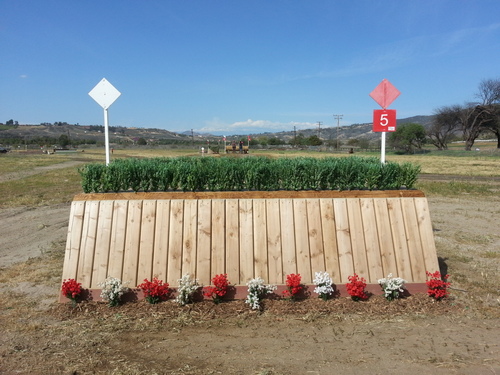Search the Site
How to Ride a Galloping Jump (Current Freebie!)

By definition, a galloping jump is one that can be jumped out of a flowing, forward gallop. What constitutes a galloping jump? Any obstacle that is built with a rampy front profile, such as in the photo posted above. Unlike a vertical profile, the slanted face allows the horse plenty of time to get his front end up even from a very deep distance - as long as the horse is balanced, and has been ridden forward to the base of the jump.
The shape of the fence, i.e. the amount of slope to the ramp in front, is one of the factors that dictates what speed is appropriate on the approach, and how much compression of the stride is necessary for a good and balanced jump. (Read this article on The Scale of Compression for a better understanding of the different gallops that might be used for different fences.) So an upright table, with a fairly vertical profile, would require a slightly different approach than one with a nice slope to it, or something like a ramp, a rolltop, a steeplechase fence, or a jump with a ditch in front of it - all true galloping jumps.
So how do you ride a galloping jump? You create a good, balanced gallop, and you keep going. The horse should jump it right out of his stride, and the rhythm before, during, and after the jump should remain the same. No big moves on the rider's part, to either increase in the final strides (which pushes the horse out of balance), or to take back and attempt to manufacture the perfect takeoff spot.
Pulling the horse out of his rhythm to find that perfect takeoff spot at a galloping fence is not only unnecessary, it can take the heart out of the horse to some degree. As it can shut down the horse's natural instinct for thinking about his own timing and footwork, and also take the fun out of it for him. Galloping jumps are the safest of all solid obstacles. So if you never just let your horse run on down to one without micro managing, how will he ever learn to take care of himself on cross country?
It is also unduly tiring on the horses when they have to change their galloping rhythm at every single fence on the course. Save that for fences that truly require a change in balance, speed, and stride length based on the question that they pose. There will always be complexes and individual fences that necessitate an adjustment - and sometimes a major adjustment. But let the horse take the galloping jumps in the most economic way possible - by taking them right in stride.
Be sure to think about this concept at the beginning of every cross country course that you ride, as the first few fences are almost always galloping jumps. Take the opportunity at the beginning of the course to set the tone of the ride. And also at every galloping fence on course to reset that tone, if riding the many technical fences has begun to change it into more of a show jumping mentality. Every galloping fence is an opportunity to awaken your horse's initiative, and show him how FUN it is to run and jump - and should be used as such.






